
The MuseumsQuartier, a large area in Vienna, is the sprawling courtyard of Vienna’s largest museum complex, containing the Architekturzentrum Wien, Kunsthalle Wien, Leopold Museum and Mumok Museum moderner Kunst Stiftung Ludwig Wien, along with the ZOOM Kindermuseum and Tanzquartier Wien. The site was originally occupied by a building, constructed in 1559, by Emperor Ferdinand I of Austria, which was turned into the Royal Stable, caring for hundreds of Spanish horses, dozens of coaches and carriages, by his son Maximilian II, the Holy Roman Emperor, after the death of his father in 1564. Much later, before and after World War II, it was used as an exhibition area and over the years, the complex of buildings transformed the area into a cultural hub and earned the current name, MuseumsQuartier, in 2001.
With more than 968,750 sq feet (90,000 sq m) of exhibition space, the complex of the MuseumsQuartier, one of the most ambitious cultural hubs in the world, is the perfect place to enjoy different types of exhibits displayed in the museums or simply hang out or meet people, especially in the warm summer evenings.

The project of renovating the court area began in April 1998 and the MuseumsQuartier opened three years later, in two stages, in June and September 2001. The MuseumsQuartier, popularly known in its short form as MQ, contains a range of installations from huge art museums like the Leopold Museum and the Mumok to contemporary exhibition spaces like the Kunsthalle Wien. In addition to the museums, the court also contains Tanzquartier Wien, an international centre for dance and the ZOOM Children's Museum, the first Austrian children's museum with several facilities.

The Architekturzentrum Wien or the Austrian Architecture Museum, popularly known by its short name Az W, was founded in 1993 and moved into its present location in MuseumsQuartie in 2001, after 8 years of provisional exhibition operations. Known as the flagship of the Austrian architecture museum, it has a rich and significant collection of Austrian architecture of the 20th and 21st centuries.
Equipped with around 10,764 sq feet (1000 sq m) of exhibition space, it had organised more than 150 exhibitions, 300 events and 600 architectural excursions in its first 15 years, ranging from symposia, workshops, lectures to guided tours, city expeditions, film series and hands-on formats.
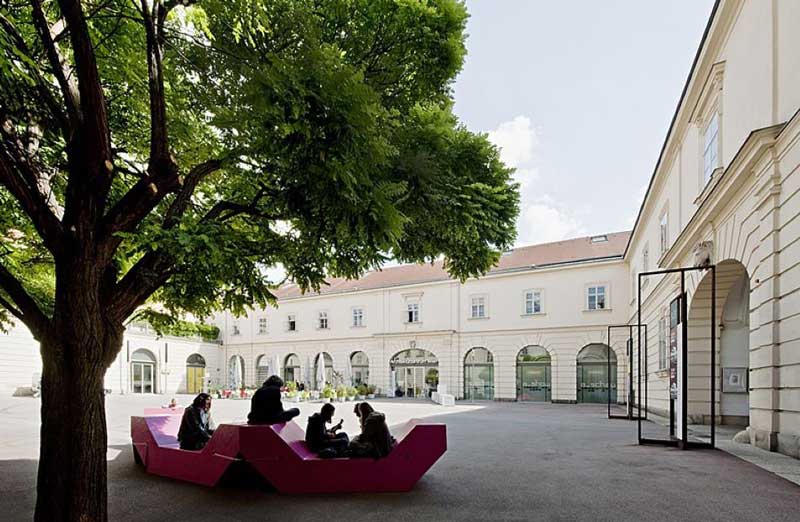
The Austrian Architecture Museum contains architectural drawings, documents, correspondence, models, photographs and slides of contemporary and newly commissioned projects, partly accessible through a computerised catalogue.
The library of the museum contains no less than 16 000 titles with the biography of the architects, exhibition catalogues and publications on architecture, as well as about 100 architectural journals, published from all over the world. As a centre for architecture, the Architekturzentrum Wien also offers a broad, professional service for everyone interested in architecture and building art.
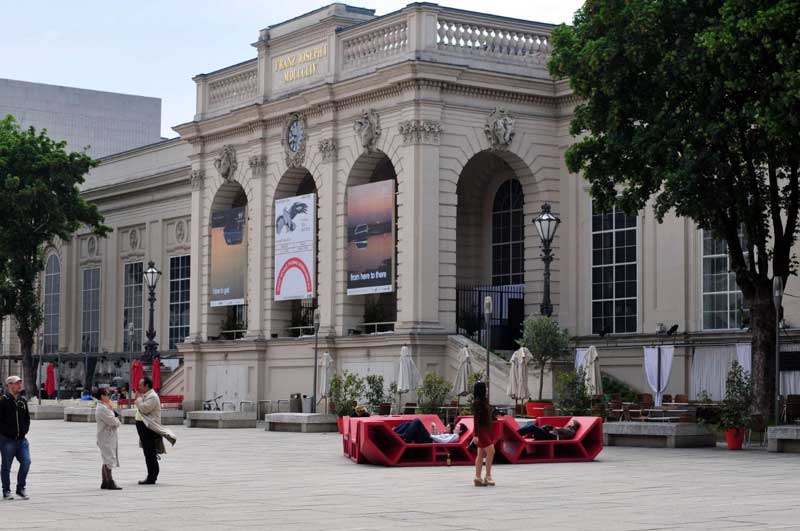
Kunsthalle Wien, an institution for international contemporary art and discourse, which was founded in 1992, runs a sister museum on Vienna’s Karlsplatz Square. Initially, Kunsthalle Wien was a makeshift structure situated at Karlsplatz and moved to its new headquarters, designed by Ortner & Ortner, the Ortner brothers, Laurids and Manfred at the MuseumsQuartier. It is both a location for exhibiting established art and a negotiation site for current societal issues, as well as future developments and comprises the broad diversity of international contemporary art and its related contemporary discourses.
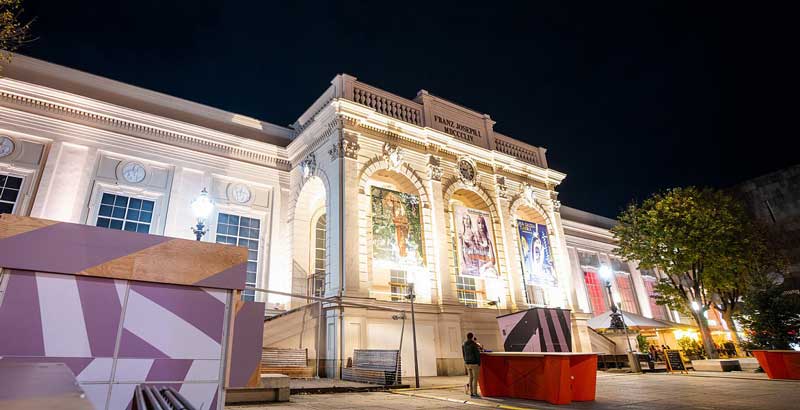
Kunsthalle Wien does not have a collection of its own, instead dedicates its changing solo and thematic exhibitions to art and its relations to social change. It organizes themed group exhibitions and solo presentations of various contemporary artists from both the Austrian as well as the international art scene and supports local and international artists. As it focuses on themed group exhibitions, solo presentations of international artists, as well as exhibitions of artists who are yet to be discovered, it has an exceptional position among Viennese cultural institutions.
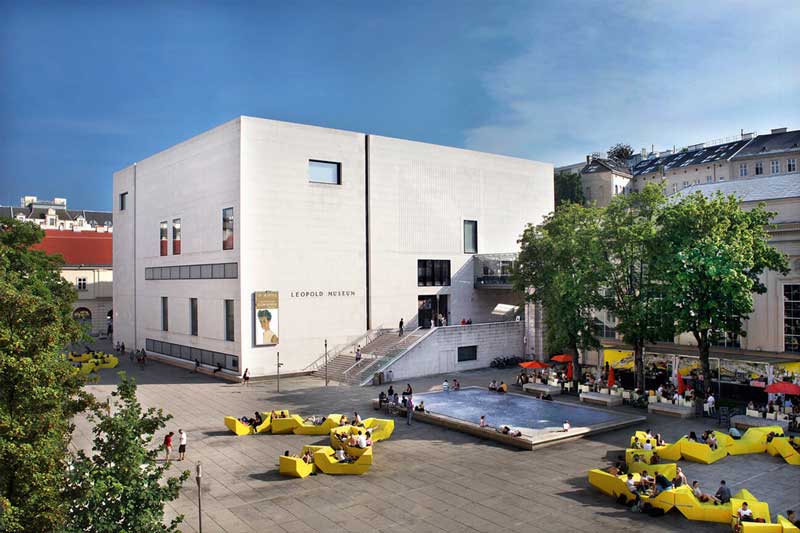
Housed in the MuseumsQuartier, the Leopold Museum is a unique treasure-trove of Viennese art nouveau and one of the largest and most frequently visited art and cultural spots in the world, containing the most important and largest collection of Egon Schiele, as well as masterpieces by the founder of the Vienna Secession movement, Gustav Klimt, along with Oskar Kokoschka, Richard Gerstl and others. It contains more than 5,000 exhibits collected by Elisabeth and Rudolf Leopold over five decades, which were consolidated in 1994 and in collaboration with the Republic of Austria and the Austrian National Bank, the said collection found its final home in the Leopold Museum Private Foundation. Later, the Leopold Museum was opened in the MuseumsQuartier in 2001.
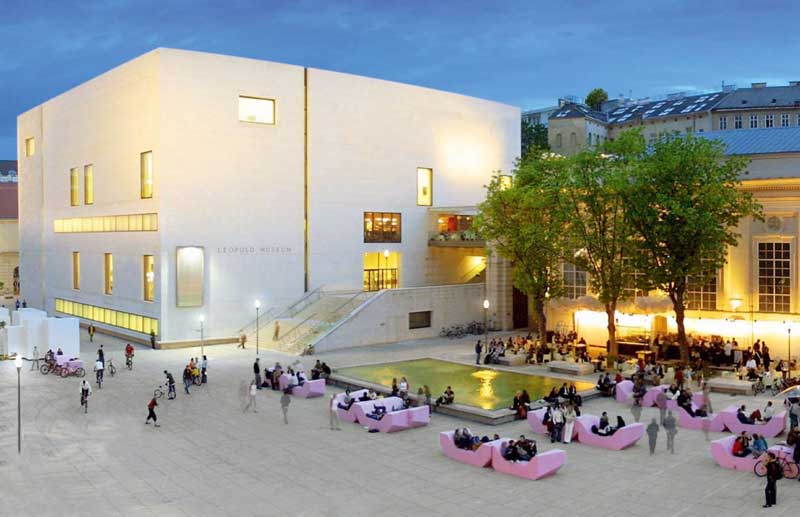
Designed by Ortner & Ortner, the Leopold Museum is a bright cube, made of white shell limestone acquired from the River Danube, seemingly perfectly synchronised with its surroundings. With an exhibition area of around 581,251 square feet (5,400 square m), sprawling over five floors, the spacious rooms awash with light, offer an ideal setting for the presentation of the invaluable Leopold Museum's collection as well as temporary exhibitions. Although daylight enters the four upper levels of the building through the equally sized windows on the sides and above, three halls are additionally illuminated through the openings of the elongated windows, placed along the upper edges of the walls. However, the lowest level of the museum has no daylight illumination and its halls, used for special exhibition purposes, are equipped with a special light ceiling.
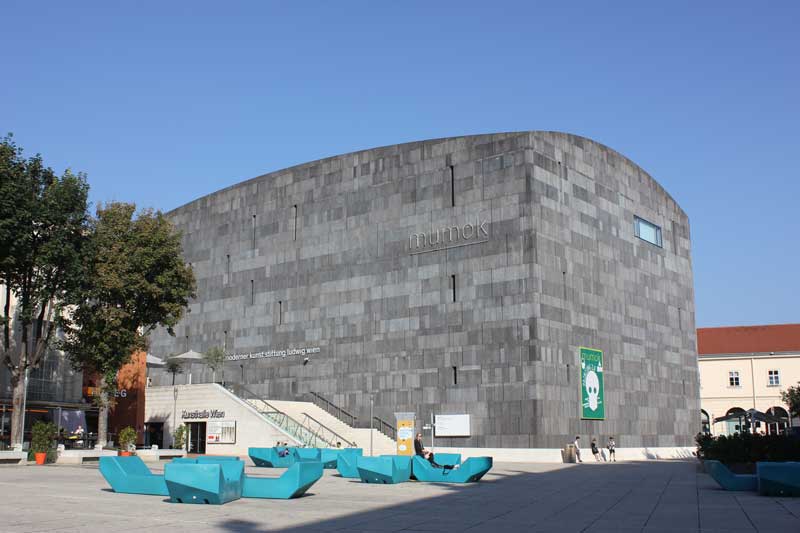
Mumok, which stands for the Mumok Museum moderner Kunst Stiftung Ludwig Wien or Museum of Modern Art Ludwig Foundation Vienna, was initially opened on 20 September 1962, as a museum of the 20th century in the Swiss Garden, located in the Austrian Pavilion of the 1958 World Exhibition in Brussels. Ultimately, it was reopened in the MuseumsQuartie on 15 September 2001, in a dark, closed block, cube building, designed by Ortner & Ortner, with a sprawling 51,666 sq feet (4.800 sq m) of exhibition space for the main works of the collection of modern and contemporary art. The building with its round edges is in sharp contrast to the bright distinctive angularity of the Leopold Museum in the vicinity. It is uniformly clad in grey basalt lava on the façades and roof surfaces, which clearly mark it different from the adjacent level and seems to emerge from the deep below. The entrance to the museum resembles a slit in the façade and the only visual exception in the whole composition is a window at the top level, flush with the wall. Today, the collection of Mumok includes around 10,000 works by around 1,600 artists, but it is continuously expanding and deepening its collection focus on reality-related as well as social and institution-analytical art from the 1960s and 1970s with contemporary works by Austrian and international artists.
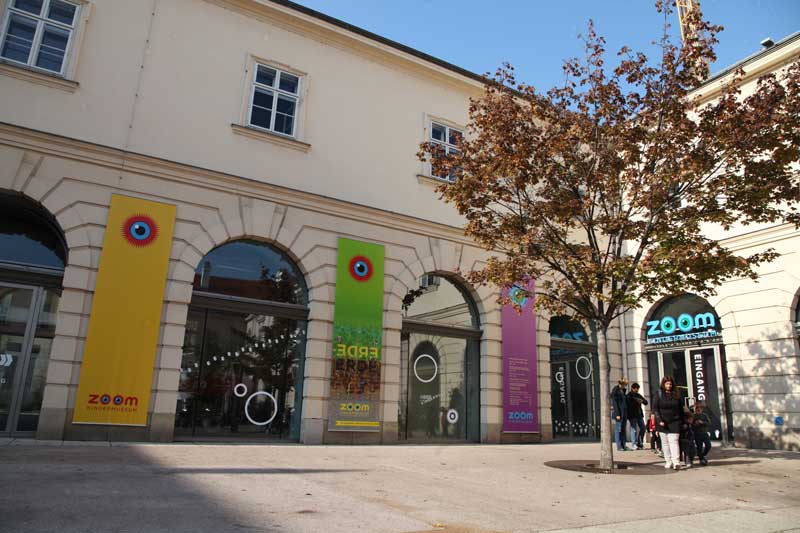
ZOOM Kindermuseum or the ZOOM Children's Museum in the MuseumQuarter is the first Austrian children's museum to offer exhibitions throughout the year, along with workshops, a multimedia laboratory and much more for children from 8 months to 14 years. It is an ideal children’s world, a place for playful education, study and experience. It is the place where the children can touch and try out objects and gain understanding through grasping. On its 17,222 sq feet (1,600 sq m), the museum offers four different areas, which include the ZOOM Exhibition, the ZOOM Studio, the ZOOM Animation Studio and the ZOOM Ocean. While the ZOOM Exhibition covers different major themes from science, art, everyday culture and architecture items tangible for children aged 6 to 12, in the ZOOM Art Studio, children are provided with much space to make dirt and are given absolutely freehand to try out techniques and materials that cannot usually be used in their houses, schools and kindergartens. The Zoom Animation Studio, meant for Children between 9 and 14, offers introductory animation workshops for the participants to create short animated video clips from their drawings, under the guidance of trained professionals. Finally, the ZOOM Ocean, designed for kids ages 8 months to 6 years, is a completely different concept of indoor playground, complete with a water grotto to explore, the mirror tunnel, a coral reef with tickle anemones, even a submarine. There is also a ship called Famosa, where kids can become sailors by operating the steering wheel and communicating with the lighthouse, or act as a fisherman, trying to catch fish or loosen knots.

However, the Tanzquartier Wien is not a museum, it is a centre for contemporary dance and performance, opened in the MuseumsQuartier in the autumn of 2001. It is the first production and event centre in Austria that focuses exclusively on the genres of contemporary dance and performance. Focused on the presentation of selected international works and the detection of current developments and trendsetting tendencies in dance creation, its productions do not hesitate to take the risk of experimenting and take on a wide variety of formats. It is a place where visitors can experience contemporary dance and performances that incorporate socio-political and or artistic discourses.

Apart from being amongst the biggest cultural areas in the world, the MuseumsQuartier has developed into a regular oasis of culture, a popular place to meet, especially in the summer days. An important contribution to this popularity is made by the colourful outdoor furniture, which invites people to relax in the inner courtyard. The modern outdoor cult furniture in the area was even awarded the Adolf Loos National Prize for Design in 2005.